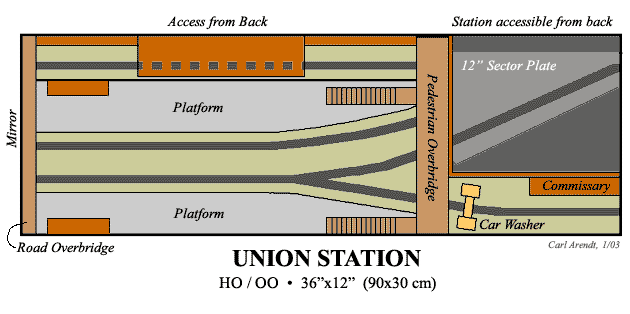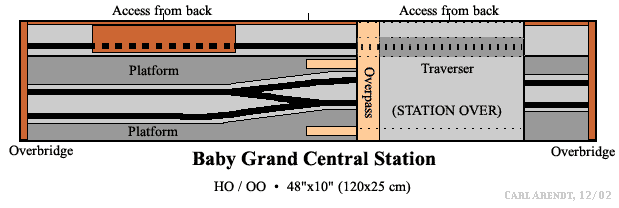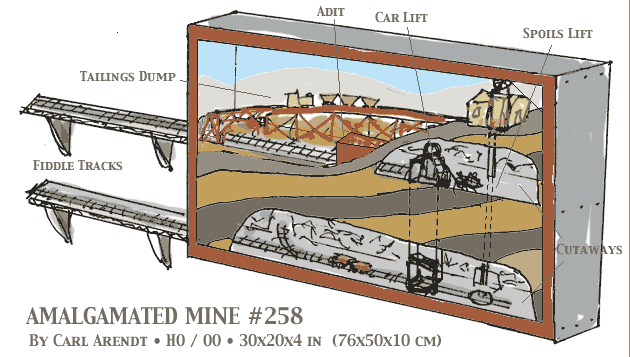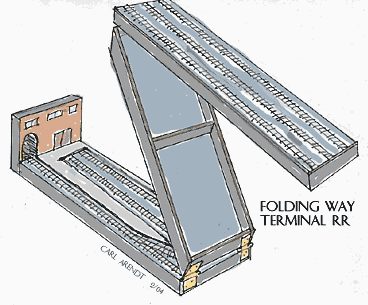Passenger Lines
Micro layouts are often thought to be only for freight or goods traffic … their size seems just too small for passenger coaches to operate. But ingenious design can find ways to cope … here are some passenger-oriented layouts.
A Micro for Passenger Operations
 Someone asked me the other day why all the layouts in this Gallery seemed to be “freight only” — “Where are the passenger trains?” she asked. I explained that passenger cars (carriages) were so large that it was nearly impossible to fit them into a tiny micro-layout format. Then I paused and started thinking about it. The result is Union Station.
Someone asked me the other day why all the layouts in this Gallery seemed to be “freight only” — “Where are the passenger trains?” she asked. I explained that passenger cars (carriages) were so large that it was nearly impossible to fit them into a tiny micro-layout format. Then I paused and started thinking about it. The result is Union Station.
This is a three-square-foot piece of a large metropolitan passenger depot. It’s shared by several railroads that run through town, so you can have varnish with different road names at the platforms. By raising the platforms from track level to three feet or so, you can move the whole thing to Britain; or leave them low and move it to Europe. This slice of a station, located between a pedestrian access overbridge and a city street crossing bridge, is suitable to represent almost any passenger station, located anywhere in the world.
It’s designed to use 60-foot cars (about 8.5″ long), which are a little more manageable in our micro world. If you want to use full-sized 80 footers, just make the layout four feet long instead of three — it’ll still work. You can make up trains at the platform, then dissassemble them and move them away via the sector plate. Use small switching locomotives, so the loco and a carriage will fit on the sector plate.
If you want to run around a car — to spot it in the servicing track at the front right, for example — just push it into the building hiding the tracks at the rear and uncouple. Remove the car by hand through the back access, run the loco through the building, return the car, recouple and voila! you’ve run around it. An improvement might be to use a Peco Loco Lift inside the building, so that it’s easy to lift the car and still keep it on the rails while the loco is running through.
Another advantage of Union Station: because each of the three tracks will hold three 60-foot cars, you can use it as an Inglenook switching puzzle. Make sure each car has a different name, then put all the names in a hat and pull out three that will form a departing train. Then make up that train, using the sector plate to access each track. Another dimension of fun with micros — Inglenook switching with passenger cars!
And finally, if you have a collection of top link motive power, this is a great place to show off your locos in their natural habitat. Convert the track at the front right to an engine servicing track, and run the locos through the layout to get there and be serviced. You’ll have your audience on the edges of their seats!
NOTE: King’s Pancreas (below) is our 150th layout plan!
It’s very fitting that this plan should be designed by Emrys Hopkins, who has contributed more layouts to this collection than anyone other than myself. This plan is his 17th contribution to the Micro Layout Design Gallery — over 10% of the total! So on this momentous anniversary of our 150th plan, I want to pay tribute to Emrys as the leading representative of all the wonderful layout designers who have made this collection possible. To see all 43 of their names, click here.
Here’s wishing us many more! Carl Arendt
An English Version …
 The unstoppable Emrys Hopkins has also been thinking about passenger operations in a micro layout format. His first passenger-layout venture (and probably not his last) is modeled on a London central station, no less! King’s Pancreas is a 72″x8″ shelf layout representing the last few platforms of a giant terminus. Emrys describes it thusly:
The unstoppable Emrys Hopkins has also been thinking about passenger operations in a micro layout format. His first passenger-layout venture (and probably not his last) is modeled on a London central station, no less! King’s Pancreas is a 72″x8″ shelf layout representing the last few platforms of a giant terminus. Emrys describes it thusly:
“King’s Pancreas is a OO/HO terminus with one of those typically Victorian arched roofs. To be strictly accurate, all we have are three of the platforms from the station and less than half of the roof, but then this is a micro layout!
“What we’re looking at are the platforms that handle the local traffic — 2 or 3 coaches and nice short engines, about 10” long at most.
“The tracks are as follows (from top to bottom):
* Platform 11 (the actual platform is either painted onto the backscene or is in extremely low relief)
* Platform 12
* Platform 13 or possibly a bay for end-loading vehicles or loco storage
* Platform 14 for Parcels traffic.
“Across the turnout from Platform 14 there’s a short siding that can either be used to store parcel vans, etc., when not in use or to store a station pilot loco. Hidden beneath the ornate roof is a 10″ traverser, which allows incoming engines to run around their trains (as at Moor Street station in Birmingham, if you need a prototype!). At the other end of the layout is a 19” traverser/cassette — just about long enough for a loco + 1 or 2 coaches, if you choose your era and rolling stock with care.
“The plan is based on features at a number of London’s termini, but can easily be transposed to another town, city or country. The backscene is vitally important for this layout — it must convey the cramped urban environment and the hustle and bustle of the surrounding city streets.
“Operational possibilities include using the station pilot locomotive to come out, draw the carriages back to the (right hand) traverser, then move them into the next platform ready for the loco to either reverse out and couple on at the other end, to leave tender first, or to disappear offstage to the hidden 0-5-0 turntable. The pilot can also remove the train to the yard for cleaning, refilling of loos, restocking of dining cars, etc., while the parcels siding is yet another shunting source.
“As an added bonus, Inglenook style puzzles are possible, using the traverser as a headshunt.”
Ed. Comment: Wow!
Another Coach Poacher
 The idea of a micro passenger terminal seems to be catching on. Here’s another fragment of a station — two platforms and a service siding — grandiosely named Baby Grand Central Station. The station itself conceals a 14″ long traverser that provides excellent shunting capabilities in this tiny 48″x10″ space.
The idea of a micro passenger terminal seems to be catching on. Here’s another fragment of a station — two platforms and a service siding — grandiosely named Baby Grand Central Station. The station itself conceals a 14″ long traverser that provides excellent shunting capabilities in this tiny 48″x10″ space.
There are two “platform extensions” emerging from under the station at the right. These are actually engine escape tracks that make it easy for the busy terminal switchers to run around the coaches and pullmans and diners and take them away via the traverser to the service track at the back. There, thanks to a sneaky rear-access opening, they can be removed from the scene and replaced by a different car entirely.
Two back to back wye switches provide the illusion of complex trackwork, without taking up too much room. This layout is designed to work with full-length 80-foot passenger cars. Each of the three long tracks can hold three cars — and that rake of three will stretch from the road overbridge at the left to just underneath the passenger overpass in front of the station … providing the illusion that the rest of the train is just beyond, out of sight in both directions.
Of course, shunting will occur one car at a time, because the traverser is just long enough to hold a small switching loco and a single coach. If your switching schedule is cleverly arranged, though, no one will ever notice that no train is longer than three cars! And of course Inglenook-style shunting puzzles can easily be arranged, using the traverser as a head shunt (switching lead).
More Passenger Operations
 Amalgamated Terminal combines a pleasingly-intricate yard throat with an impressive three-platform covered concourse to represent part of a shared terminus in a medium sized city anywhere in the world. It’s designed to handle full-length (80-foot) passenger cars in HO or OO.
Amalgamated Terminal combines a pleasingly-intricate yard throat with an impressive three-platform covered concourse to represent part of a shared terminus in a medium sized city anywhere in the world. It’s designed to handle full-length (80-foot) passenger cars in HO or OO.
A key feature is the carefully sited viewblocks in the form of road overbridges. They reveal only two coaches and part of a locomotive in the open spaces they create. As a result, two- or three-coach trains can give the illusion of being realistically long, as the viewer’s eye can never see the whole train at once.
When the Overnight Express pulls into Amalgamated and comes to a slow halt the terminal switch engine, which has been lurking in the engine ready track, pulls off the varnish and deposits it in a departure track, freeing the loco to pull out and head for the service area (a.k.a. the Fiddle Yard). There it’s supposedly fed and watered and cleaned, as well as actually being turned (by hand) for the outbound journey.
A little study will show you that, with two trains in the terminal, you are going to have some fun switching cars and locos around to get a third train into the platform while simultaneously engineering a pair of ontime departures! Switching fun, including Inglenook style shunting puzzles, is the main activity on Amalgamated Termnal — besides providing a natural environment for admiring those gleaming coaches!
As an afterthought, I’ve slightly realigned the Amalgamated trackage (below) to make it highly portable by fitting it on a pair of the folding platforms introduced by Jack Trollope and used by Giles Barnabe in Foldingham (U.S. Style). In this case, baseboard depth at both ends is 10″ and at the center is 5″. Dividing the layout at the heavy center line and folding the two halves at the hinges will break the whole affair down into two 15″x18″ rectangles, which can easily be packaged as a convenient carrying case!
A ‘Quick Setup’ Foldaway Plan
 I’ve become particularly fond of the absurd arrangement of turnouts and crossing in the Triple-I Industrial Park plan. So I rearranged the spurs slightly to produce this hard-working passenger terminal arrangement, Folding Way Terminal. The other part of the inspiration for this layout comes from the humble carpenter’s rule, which accordian-folds into a very compact package.
I’ve become particularly fond of the absurd arrangement of turnouts and crossing in the Triple-I Industrial Park plan. So I rearranged the spurs slightly to produce this hard-working passenger terminal arrangement, Folding Way Terminal. The other part of the inspiration for this layout comes from the humble carpenter’s rule, which accordian-folds into a very compact package.
 This three-part baseboard is cunningly hinged to fold together, one-two-three, and permits an early getaway from the operating room. When it’s time to go, just remove the overpasses (and the backdrop, if you choose to have one), fold the 72″x8″ layout as shown in the sketch, tuck the resulting 24″x8″x6″ parcel under your arm , and depart.
This three-part baseboard is cunningly hinged to fold together, one-two-three, and permits an early getaway from the operating room. When it’s time to go, just remove the overpasses (and the backdrop, if you choose to have one), fold the 72″x8″ layout as shown in the sketch, tuck the resulting 24″x8″x6″ parcel under your arm , and depart.
As with other layouts in this section, the overpasses are arranged to cut off the spectators’ views at about 22 inches of train — roughly a locomotive and two short coaches. So we can run abbreviated trains that suit the 23-inch platform lengths admirably and appear to be much longer than they actually are.
As drawn, the platforms are track-height, following American and continental European practice. If you prefer British style raised platforms, the hinging must be adjusted a bit to accommodate the extra thickness in the bottom shelf, and the overall package will measure something like 24″x8″x7″ (60x20x18 cm)…no problem.
The low-relief station building at the end is a permanent fixture and helps to stabilize the package when the layout is folded up. A minimum of two locomotives will be required to operate this layout — a mainline engine to bring in the coaches, and a terminal shunter to “pull the varnish” out of the way and release the road locomotive to the loco servicing yard (in the Fiddle Yard, reached via the right front track). Trains are made up and dispatched in the Fiddle Yard, which could also contain a traverser (transfer table).
One operational comment: if you declare this station to be a shared facility among several railroads serving the same town, you can justify a wide variety of motive power and passenger equipment showing up at this relatively small installation. That’s the “Union Station” plan of operation. You could even have a preserved, tourist railway sharing the terminal as well — so old-time equipment can also be seen at the platforms!